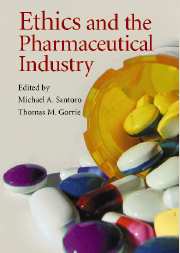Book contents
- Frontmatter
- Contents
- Tables
- Figures
- About the Editors
- Contributors
- Preface
- Acknowledgments
- Foreword
- Introduction: Charting a Sustainable Path for the Twenty-First Century Pharmaceutical Industry
- PART I PROFITS, PATIENTS' RIGHTS, AND SCIENTIFIC PROGRESS: THE ETHICS OF CLINICAL RESEARCH CONDUCTED IN PRIVATE ENTERPRISES
- PART II MARKETING AND THE EFFICIENT UTILIZATION OF HEALTHCARE RESOURCES: ETHICAL AND PUBLIC POLICY CHALLENGES
- Introduction to Part II
- 8 Ethics and Prescribing: The Clinician's Perspective
- 9 The Regulation of Prescription Drug Promotion
- 10 Direct-to-Consumer Advertising of Prescription Drugs: A Policy Dilemma
- 11 Off-Label Communications and Prescription Drugs
- 12 The Need for Better Health Information: Advancing the Informed Patient in Europe
- 13 Who Should Get Access to Which Drugs? An Ethical Template for Pharmacy Benefits
- 14 The Application of Cost-Effectiveness and Cost–Benefit Analysis to Pharmaceuticals
- PART III PATENTS, PRICING, AND EQUAL ACCESS
- PART IV CONCLUDING THOUGHTS: CHARTING A SUSTAINABLE PATH FOR THE TWENTY-FIRST CENTURY
- Notes
- Index
14 - The Application of Cost-Effectiveness and Cost–Benefit Analysis to Pharmaceuticals
Published online by Cambridge University Press: 04 December 2009
- Frontmatter
- Contents
- Tables
- Figures
- About the Editors
- Contributors
- Preface
- Acknowledgments
- Foreword
- Introduction: Charting a Sustainable Path for the Twenty-First Century Pharmaceutical Industry
- PART I PROFITS, PATIENTS' RIGHTS, AND SCIENTIFIC PROGRESS: THE ETHICS OF CLINICAL RESEARCH CONDUCTED IN PRIVATE ENTERPRISES
- PART II MARKETING AND THE EFFICIENT UTILIZATION OF HEALTHCARE RESOURCES: ETHICAL AND PUBLIC POLICY CHALLENGES
- Introduction to Part II
- 8 Ethics and Prescribing: The Clinician's Perspective
- 9 The Regulation of Prescription Drug Promotion
- 10 Direct-to-Consumer Advertising of Prescription Drugs: A Policy Dilemma
- 11 Off-Label Communications and Prescription Drugs
- 12 The Need for Better Health Information: Advancing the Informed Patient in Europe
- 13 Who Should Get Access to Which Drugs? An Ethical Template for Pharmacy Benefits
- 14 The Application of Cost-Effectiveness and Cost–Benefit Analysis to Pharmaceuticals
- PART III PATENTS, PRICING, AND EQUAL ACCESS
- PART IV CONCLUDING THOUGHTS: CHARTING A SUSTAINABLE PATH FOR THE TWENTY-FIRST CENTURY
- Notes
- Index
Summary
Why economic analysis of pharmaceuticals is important
Healthcare costs are continuing to escalate rapidly around the globe, reflecting aging populations, greater access to medical services, and improved medical technologies. In 2002 U.S. healthcare expenditures reached $1.6 trillion, 15 percent of that year's gross domestic product, and $5,440 per capita. As shown in Figure 14.1, pharmaceutical expenditures have been escalating even more rapidly than overall healthcare expenditures over the past decade, reaching 10 percent of overall healthcare spending for the first time in forty years.
In 1970, early in Medicare and Medicaid implementation, prescription drug spending was $43 per capita, and the lack of Medicare drug coverage was not a major political concern. By 2002, as political momentum for a Medicare prescription drug coverage program neared its peak, prescription drug expenditures reached $569 per capita, with the Medicare population spending nearly quadruple this amount. Drug spending and drug insurance coverage have become prominent U.S. economic and political issues.
Similar concerns about drug spending are surfacing globally. Per capita drug expenditures vary widely internationally, reflecting differences in economic circumstances, pricing policies, government programs, and population characteristics. Nevertheless, drug expenditures are increasing rapidly in all industrialized countries (see Figure 14.2).
Health economists vigorously debate whether healthcare costs generally and pharmaceutical costs specifically are rising too rapidly. Many say that healthcare is precisely the kind of superior good that people consume more of as their income and wealth rise.
- Type
- Chapter
- Information
- Ethics and the Pharmaceutical Industry , pp. 225 - 248Publisher: Cambridge University PressPrint publication year: 2005
- 1
- Cited by



